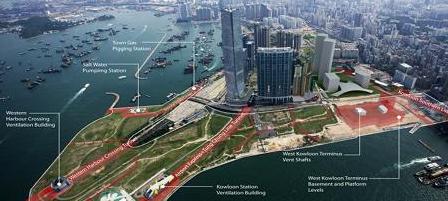Turn West Kowloon Into A Market
Next Magazine (2014.07.10, A002, Second Opinion, Bill Stacey)
Eleven years after closing, there remains controversy about plans to preserve and redevelop the Central Market. At least we now have some rather bold plans, but apparently some people still object to the number of commercial outlets in the plans. So the site remains idle, used only as a connection to the escalator and public toilets.
In countries with more space, there is the phenomenon of the “NIMBY” – which opposes development on the principle of “not in my back yard”. Hong Kong’s equivalent opposes development that does not meet their narrow esthetic preferences and views about what other people should do with their time and tastes.As a result, almost every new project or revitalization initiative, from the Police Married Quarters to the Central Police Station and even the Central Market, must have at their core an artistic or “creative” purpose. Not to mention the West Kowloon Cultural District. Mere commerce or business is decried as something that Hong Kong has too much of; descrying it as a monster that needs to be contained lest it attracts more tourists.Yet commerce and markets are at the heart of every great city. Imagine Istanbul without the Grand Bazaar? London’s Covent Garden gains its vibrancy from its market origins and seedy neighbors. Originally the theatres of London and New York came to the market places that attracted people. Now people are attracted to those theatres. Advocates of developing the arts and culture do their cause a disservice with their pleading for government-provided premises and subsidies that can only sap the creativity that helps culture to thrive. Every time that land is reserved for an under-utilized cultural monument, it means less land for commercial and residential purposes, and therefore higher costs for those who are genuinely creative but have no desire in tackling the bureaucratic maze in applying for privileged space within the official arts community. Every subsidy begets the need for higher taxes that leaves less income, wealth and dynamism to support the whims that might sometimes lead to great art.Districts of Hong Kong that are attractive for the arts are places that bring people together, be that for work or leisure. When it comes to Asia’s World city, there is no more important leisure activity than eating. Yet along the waterfronts of Victoria Harbor there are growing miles of “public open space”, where the distaste of some for commerce denies the throngs of people enjoying the environment even an iced lemon tea, much less fish balls and noodles.
Street theatre goes hand in hand with street stalls and hawker food. New bands need underused warehouses, not carefully designed artistic spaces. Hong Kong does not have a dearth of creative talent. Artistic talents are already making districts like Sheung Wan and Western District – where smaller spaces are available more cheaply – centers for new businesses, innovative food, fashion and design.Particularly in the new world of social media and online businesses there is a very fine line between the creative arts and entrepreneurial commerce. In any Internet business, design talent is amongst the most important, the most rewarded and the hardest to find. There is not a formula for developing artistic and creative talents. However, it is often the case that with great gifts come great flaws. There is a reason why theatre districts often evolve not only close to markets, but also red light districts, night -life and other temptations. Great talents are rarely to be found filling out forms to apply for government grants and office space in nicely developed clean new government projects with lots of facilities. They are more likely to be dealing with the raw human condition that inspires great art.Let’s dispense with grand projects, turn the West Kowloon Cultural District into a market, divide the space into small, unplanned lots, save some money, reduce taxes and hope that a red light district emerges next door. The resulting spontaneous order is sure to give a fillip to the arts in Hong Kong.
Bill Stacey is in his 10th year as a resident of Hong Kong and is Chairman of the Lion Rock Institute.We are now on Facebook http://www.facebook.com/

